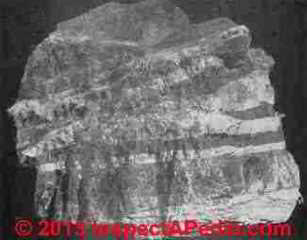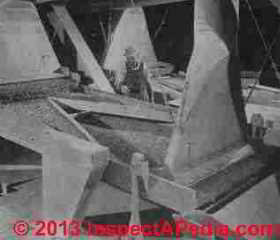 Asbestos Mining Processing Methods
Asbestos Mining Processing Methods
How was Asbestos Mined & Asbestos Ore Processed?
- POST a QUESTION or COMMENT about what building materials may contain asbestos, visual identification of asbestos-containing materials in buildings, and possible asbestos material identification by testing, use, age, appearance
Asbestos mining processes: where and how was asbestos mined around the world. This article describes the processes used to mine and prepare asbestos for industrial use, describing both hand and machine mining and asbestos or preparation.
This articles series about the manufacture & use of asbestos-containing products includes detailed information on the production methods, asbestos content, and the identity and use of asbestos-containing materials.
InspectAPedia tolerates no conflicts of interest. We have no relationship with advertisers, products, or services discussed at this website.
- Daniel Friedman, Publisher/Editor/Author - See WHO ARE WE?
Asbestos Mining, Milling, Processing Methods
 The method of mining, milling, and processing asbestos
depends on the type of asbestos being handled as well as
such specific physical characteristics as soft versus harsh
fiber. Since chrysotile fiber accounts for approximately 95
per cent of all the asbestos used, this discussion will pertain
to Canadian chrysotile.
The method of mining, milling, and processing asbestos
depends on the type of asbestos being handled as well as
such specific physical characteristics as soft versus harsh
fiber. Since chrysotile fiber accounts for approximately 95
per cent of all the asbestos used, this discussion will pertain
to Canadian chrysotile.
Photo at left illustrates Crocidolite asbestos under the microscope, photo by Daniel Friedman while at McCrone Research Institute. [Click to enlarge any image]
For a satisfactory mining operation, the content of fiber in the rock should range from 3 to 12 per cent. Such variables as availability of labor, transportation facilities, and size of the deposit determine whether or not a low asbestos content mine will be a profitable operation.
Separately at ASBESTOS PRODUCTION QUANTITY we give tables of the quantities of asbestos ore that was produced, organized by country and by asbestos ore type.
Asbestos Ore Mining Methods
Description of Hand-Cobbing Asbestos Mining
 Hand cobbing is the oldest method used in mining asbestos.
This particular method is still used in order to obtain
the long asbestos fibers (Crudes 1 and 2).
Hand cobbing is the oldest method used in mining asbestos.
This particular method is still used in order to obtain
the long asbestos fibers (Crudes 1 and 2).
The hand cobbing asbestos mining operation involves releasing fiber from the asbestos ore rock by means of manually (by hand) hammering away the rock from the ends of fibers. This type of fiber is not processed through the standard crushing units during the milling operation of the shorter filers. See Figure 1.4 at left
Several processes or systems are used by the mines to process the milled fibers in order to release rock and fiberize bundles of fibers.
Figure 1.4. Single-Fiber Asbestos Vein (hand cobbed).
Description of Asbestos Ore Rock Processing by Machine
 Asbestos fiber is found in rock deposits classified as cross
fiber, slip fiber, and mass fiber. Asbestos usually occurs as
cross fiber in which the fiber runs at relative right angles to
the walls of the rock; see Figure 1.5 shown at left.
Asbestos fiber is found in rock deposits classified as cross
fiber, slip fiber, and mass fiber. Asbestos usually occurs as
cross fiber in which the fiber runs at relative right angles to
the walls of the rock; see Figure 1.5 shown at left.
The asbestos fiber length rarely exceeds 2 or 3 in.
Figure 1.5. Cross-fiber asbestos veins
The average long fiber asbestos for chrysotile is 3/4 in. In some cases a bend occurs in the fiber which results in a fiber that is weak at the point of benching.
In slip fibers, the fibers lie in the direction parallel to the seam or crack in the rock. Generally, this type of fiber is weaker than the cross fiber. It is considered unsuitable for spinning.
In the mass fiber classification, there is a complete absence of any orientation of fiber. The asbestos is distributed at random. This type of formation generally occurs with the amphibole varieties of asbestos. The fibers tend to be soft.
There are two methods of extraction which are similar to those used for iron ore, namely, open pit and underground mining. The open pit method is the more desirable because it is much cheaper and less complicated.
To open a quarry or pit mine, it is first necessary to remove surface matter. After this, standard blasting techniques are used to loosen the asbestos- containing rocks.
Milling / Crushing Methods for Asbestos Production
 After the asbestos ore has been mined, the material goes
through repetitive crushing operations to separate the asbestos
from the rock. Crushing and screening operations
occur. These operations are referred to as milling. Special
mill equipment is required for these operations.
After the asbestos ore has been mined, the material goes
through repetitive crushing operations to separate the asbestos
from the rock. Crushing and screening operations
occur. These operations are referred to as milling. Special
mill equipment is required for these operations.
The methods used in the various mines are basically the same; however, they generally differ in size, depending on the mine capacity and type of fiber.
Figure 1.6. Big chunks of asbestos rocks are dumped into the jaws of a primary crusher to be broken into rock less than 6 in. square. After further crushing, the ore is milled to remove valuable asbestos fiber and the useless rock, or "tailings," is discarded onto a waste pile. (Courtesy Ruberoid Corp.)
In milling, the two major objectives are to separate asbestos from the rock and to prevent reduction in the length of the asbestos fiber. The value of asbestos fiber depends mainly upon fiber length; thus, the prevention of reduction in length is vital.
The primary crusher, usually of the jaw type, has the capacity to handle rocks up to 48 in., weighing as much as a ton or more, and to crush them to approximately 5 to 6 in. in width. See Figure 1.6 at below left.
Crushed rock is carried to trommel screens. These screens are large revolving cylinders with openings of various size. The trommel screens permit only the relatively small rocks, approximately 5 to 6 in. in width, to continue to the secondary stage of crushing.
This type of crusher is generally a gyratory or cone crusher. Crushed rock is dried in tower or rotary driers which vary in temperature from 2000 to 1,000° F.
Figure I.6. Big chunks of asbestos rocks are dumped into the jaws of a primary crusher to be broken into rock less than 6 in. square. After further crushing, the ore is milled to remove valuable asbestos fiber and the useless rock, or "tailings," is discarded onto a waste pile. (Courtesy The Ruberoid Co.)
In order to remove asbestos successfully, the material must be dry. The mined asbestos contains moisture which varies depending U0fl weather conditions and the season of the year. The moisture is removed by means of mechanical driers. The dry fiber can then easily be removed by air suction. The process of separating asbestos from rock during the milling operation takes into account the specific gravity difference of the two materials.
After the drying operation, the rocks which range in size from 2 to 3 in. are fed into a third crushing unit which is H either of the gyratory type or of the cone type. The crushed ore and fiber are fed to heavy shaker or bumper screens which are operated by means of eccentric drives. Powerful air suction hoods remove fiber. The rock passes over the end of the screens. The undersize material then passes through the screen, after which it is fed to a fiberizer for further treatment..
Additional shaking screens are used to separate fibers into long , medium and short categories. Duplex shaking screens are used. The long fibers remain on time top of time screen, the medium fibers in time lower screen and time short fiber passes through both screens.
 The asbestos ore rock which was passed
over the end of the heavy shaking screens continues to other
crushers. The cycle is repeated whereby the crushed rock
passes over shaking screens and in turn fiber is removed by
air-suction.
The asbestos ore rock which was passed
over the end of the heavy shaking screens continues to other
crushers. The cycle is repeated whereby the crushed rock
passes over shaking screens and in turn fiber is removed by
air-suction.
After the last crushing cycle, the remaining rock is separated by means of fiberizers. The fiberizers break the rocks by means of impact or direct blow of high speed hammers. The crushed stone is again fed through the shaking screen in order to remove additional fiber. See Figure 1.7 at left.
Figure 1.7. Shaking tables are the key to asbestos fiber separation. Finally crushed ore is passed over a Vibrating SCCefl which forces fibers to lice above the heavier bits of rock.
The milling operations are continuous. After the crushing and suction operations, the asbestos is cleaned, graded and put into bags for shipment.
At the end of the table the vacuum pick-tip captures the loose asbestos, draws it through grading screens and into storage bins for packing. (Courtesy The Ruberoid Co.)
...
Continue reading at ASBESTOS PRODUCTION QUANTITY or select a topic from the closely-related articles below, or see the complete ARTICLE INDEX.
Suggested citation for this web page
ASBESTOS MINING & PROCESSING at InspectApedia.com - online encyclopedia of building & environmental inspection, testing, diagnosis, repair, & problem prevention advice.
Or see this
INDEX to RELATED ARTICLES: ARTICLE INDEX to ASBESTOS HAZARDS
Or use the SEARCH BOX found below to Ask a Question or Search InspectApedia
Ask a Question or Search InspectApedia
Try the search box just below, or if you prefer, post a question or comment in the Comments box below and we will respond promptly.
Search the InspectApedia website
Note: appearance of your Comment below may be delayed: if your comment contains an image, photograph, web link, or text that looks to the software as if it might be a web link, your posting will appear after it has been approved by a moderator. Apologies for the delay.
Only one image can be added per comment but you can post as many comments, and therefore images, as you like.
You will not receive a notification when a response to your question has been posted.
Please bookmark this page to make it easy for you to check back for our response.
IF above you see "Comment Form is loading comments..." then COMMENT BOX - countable.ca / bawkbox.com IS NOT WORKING.
In any case you are welcome to send an email directly to us at InspectApedia.com at editor@inspectApedia.com
We'll reply to you directly. Please help us help you by noting, in your email, the URL of the InspectApedia page where you wanted to comment.
Citations & References
In addition to any citations in the article above, a full list is available on request.
- Rosato, D.V., Asbestos, its Industrial Applications, D.V. Rosato, engineering consultant, Newton MA, Reinhold Publishing Co., NY, 1959, Library of Congress Catalog No. 59-12535. Excerpts & adaptations are found in InspectApedia.com articles on asbestos history, production & visual identification in and on buildings.
Re-printed online with additional annotations, photos, and information, beginning at
ASBESTOS, ITS INDUSTRIAL APPLICATIONS, ROSATO 1959 - [2] "Asbestos in Plastic Compositions", A.B. Cummins, Modern Plastics [un-dated, pre 1952]
- [3] "Asbestos in Your Home," Spokane County Air Pollution Control Authority, Spokane WA 509-477-4727 www.scapa.org provides a one-page image, a .pdf file drawing of a house warning of some possible sources of asbestos in the home. The sources are not ranked according to actual risk of releasing hazardous levels of airborne asbestos fibers and the list is useful but incomplete.
- [4] The US EPA provides a sample list of asbestos containing products epa.gov/earth1r6/6pd/asbestos/asbmatl.htm
- [5] "Characterization of asbestos exposure among automotive mechanics servicing and handling asbestos-containing materials", Gary Scott Dotson, University of South Florida, 1 June 2006, web search 3/9/2012 original source: scholarcommons.usf.edu/cgi/viewcontent.cgi?article=3505&context=etd [copy on file as /hazmat/Automotive_Asbestos_Exposure.pdf ].
- [6] Asbestos Identification and Testing References
- Asbestos Identification, Walter C.McCrone, McCrone Research Institute, Chicago, IL.1987 ISBN 0-904962-11-3. Dr. McCrone literally "wrote the book" on asbestos identification procedures which formed the basis for current work by asbestos identification laboratories.
- Stanton, .F., et al., National Bureau of Standards Special Publication 506: 143-151
- Pott, F., Staub-Reinhalf Luft 38, 486-490 (1978) cited by McCrone
- [6] ASBESTOS IN YOUR HOME U.S. EPA, Exposure Evaluation Division, Office of Toxic Substances, Office of Pesticides and Toxic Substances, U.S. Environmental Protection Agency, Washington,D.C. 20460
- [7] Asbestos products and their history and use in various building materials such as asphalt and vinyl flooring includes discussion which draws on ASBESTOS, ITS INDUSTRIAL APPLICATIONS, ROSATO 1959, D.V. Rosato, engineering consultant, Newton, MA, Reinhold Publishing, 1959 Library of Congress Catalog Card No.: 59-12535 (out of print, text and images available at InspectAPedia.com).
- [8] "Handling Asbestos-Containing roofing material - an update", Carl Good, NRCA Associate Executive Director, Professional Roofing, February 1992, p. 38-43
- [9] EPA Guidance for Controlling Asbestos-Containing Materials in buildings, NIAST, National Institute on Abatement Sciences & Technology, [republishing EPA public documents] 1985 ed., Exposure Evaluation Division, Office of Toxic Substances, Office of Pesticides and Toxic Substances, U.S. Environmental Protection Agency, Washington,D.C. 20460
- EPA ASBESTOS MATERIALS BAN: CLARIFICATION 1999
- Basic Information about Asbestos, US EPA, web search 08/17/2010, original source: http://www.epa.gov/asbestos/pubs/help.html
- "Handling Asbestos-Containing roofing material - an update", Carl Good, NRCA Associate Executive Director, Professional Roofing, February 1992, p. 38-43
- EPA Guidance for Controlling Asbestos-Containing Materials in buildings, NIAST, National Institute on Abatement Sciences & Technology, [republishing EPA public documents] 1985 ed., Exposure Evaluation Division, Office of Toxic Substances, Office of Pesticides and Toxic Substances, U.S. Environmental Protection Agency, Washington,D.C. 20460
- EPA, ASBESTOS IN YOUR HOME [PDF] - U.S. EPA, Exposure Evaluation Division, Office of Toxic Substances, Office of Pesticides and Toxic Substances, U.S. Environmental Protection Agency, Washington,D.C. 20460
- Vermiculite:
Protect Your Family from Asbestos-Contaminated Vermiculite Insulation, U.S. EPA , web search 08/17/2010, original source: http://www.epa.gov/asbestos/pubs/verm.html
Web search 01/20/2011, original source: http://epa.gov/asbestos/pubs/verm_questions.html - Proteja su familia del aislante de vermiculita contaminado con asbesto, U.S. EPA HOJA INFORMATIVA - Proteja a su familia del aislante de vermiculita contaminado con asbestos, web search 08/17/2010, original source http://www.epa.gov/asbestos/pubs/verm-ques-sp.pdf
- [copy on file as /hazmat/Vermiculite_US_EPA.pdf/ Current Best Practices for Vermiculite Attic Insulation - May 2003, U.S. EPA
- [copy on file as] /hazmat/Vermiculite_Health_Canada.pdf] Vermiculite Insulation Containing Amphibole Asbestos - September 2009, Health Canada
- Managing Asbestos in Place, How to Develop and Maintain a Building Asbestos Operations and Maintenance (O&M) Program, U.S. EPA, web search 01/20/2011, original source: http://www.epa.gov/asbestos/pubs/management_in_place.html
- Asbestos Strategies, Lessons Learned about Management and Use of Asbestos: Report of Findings and Recommendations on the Use and Management of Asbestos, 16 May 2003, US EPA, web search 01/20/2011, original source: http://www.epa.gov/asbestos/pubs/asbstrategiesrptgetf.pdf
prepared by the: Global Environment & Technology Foundation, 7010 Little River Turnpike, Suite. 460, Annandale VA 20003 - Other US EPA Publications on asbestos: web search 01/20/2011, see http://www.epa.gov/asbestos/pubs/pubs.html
- In addition to citations & references found in this article, see the research citations given at the end of the related articles found at our suggested
CONTINUE READING or RECOMMENDED ARTICLES.
- Carson, Dunlop & Associates Ltd., 120 Carlton Street Suite 407, Toronto ON M5A 4K2. Tel: (416) 964-9415 1-800-268-7070 Email: info@carsondunlop.com. Alan Carson is a past president of ASHI, the American Society of Home Inspectors.
Thanks to Alan Carson and Bob Dunlop, for permission for InspectAPedia to use text excerpts from The HOME REFERENCE BOOK - the Encyclopedia of Homes and to use illustrations from The ILLUSTRATED HOME .
Carson Dunlop Associates provides extensive home inspection education and report writing material. In gratitude we provide links to tsome Carson Dunlop Associates products and services.

